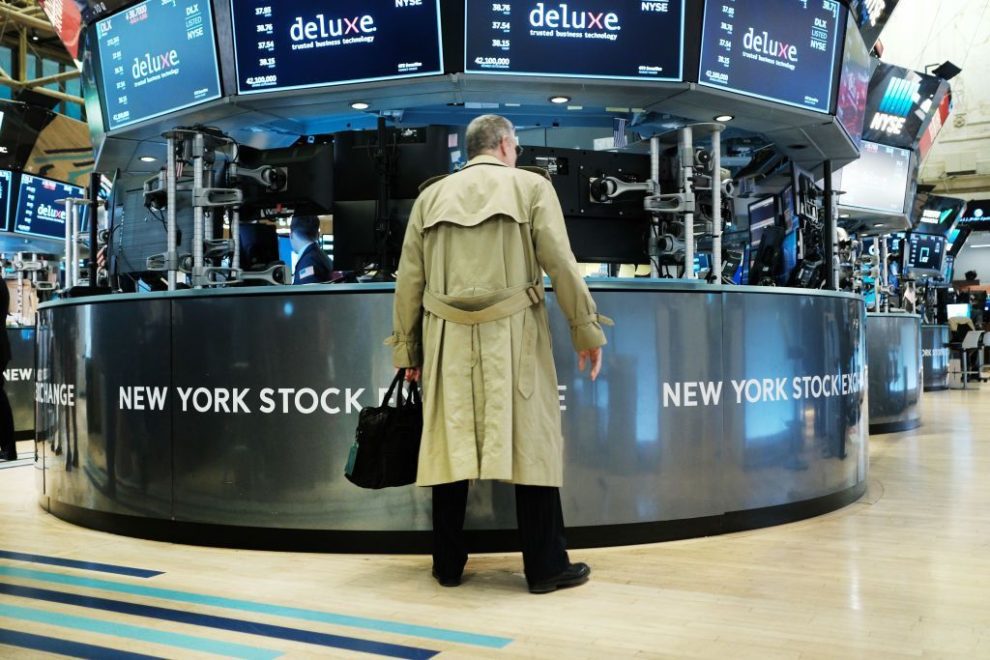
(Bloomberg Opinion) — The stock market with the most to lose from a wider coronavirus outbreak is the one in the U.S.
Global markets sold off on Monday and Tuesday on reports that authorities are struggling to contain the virus, which has now spread to more than 30 countries and increasingly threatens the global economy. Until this week, the declines in global stocks seemed to be driven by proximity to the virus’s epicenter in China, but it’s becoming increasingly clear that few markets will escape harm if the virus isn’t contained.
What’s not clear is which stock markets would suffer the sharpest declines. That obviously depends on how the crisis unfolds — where the virus spreads, how many people are affected, the impact on regional economies and trading routes, and so forth. But it also depends on the extent to which markets have already digested the potential risks, and by that criterion, the U.S. stock market appears particularly vulnerable.
To see stock investors at their most carefree, take a look at the NYSE FANG+ Index. It’s a pantheon of the Great Disruptors – 10 companies that many investors believe are poised to dominate their respective industries. In order of market value, they are Apple Inc., Amazon.com Inc., Google parent Alphabet Inc., Facebook Inc., Alibaba Group Holding Ltd., NVIDIA Corp., Netflix Inc., Tesla Inc., Baidu Inc. and Twitter Inc. As a group, they are among the most extravagantly priced stocks in history, even for growth stocks.
By any measure of price relative to earnings, the FANG index is nearly as expensive as the Russell 1000 Growth Index was at the peak of the dot-com mania two decades ago — or even more so. The price-to-earnings ratio of the FANG index is 34 based on analysts’ estimates of this year’s earnings per share, which is just 6% cheaper than the comparable P/E ratio for the growth index in March 2000. Other measures are even less flattering. Based on last year’s earnings, the FANG index’s P/E ratio jumps to 55, or an 8% premium over the comparable ratio for the growth index. And using an average of inflation-adjusted earnings over the last 10 years, it jumps again to 73, or a 16% premium over the growth index.
Investors value the FANG index’s revenue even more than its profits. The price-to-sales ratio of the FANG index is 5.9, or 41% higher than the growth index’s P/S ratio of 4.2 in March 2000. Suffice it to say, when it comes to the FANGs, the market appears to have little concern for the risks around coronavirus or anything else.
The reason that’s a potential problem for the U.S. is that eight of the 10 stocks in the FANG index are American companies. Remember that stocks in broad-market gauges such as the S&P 500 Index or Russell 1000 Index are weighted based on their market value. Therefore, as the market value of the stocks in the FANG index has spiked relative to others, so has their weighting in broad-market indexes. Those eight U.S. stocks represent less than 1% of the Russell 1000 by number, but they now account for more than 13% of its market value.
That more than anything else explains the wide gap in the valuation between U.S. and foreign stocks. The P/E ratio of the Russell 1000 is 29, based on an average of inflation-adjusted earnings over the last 10 years, which captures the growth of both earnings and stock prices during the decade. By comparison, the P/E ratio of the MSCI ACWI ex USA Index, a gauge of global stocks excluding the U.S., is 19. That’s a premium of 53% for U.S. over foreign stocks, the largest since the data series begins in 1998.
If the virus turns out to be a serious and sustained threat to the global economy, markets are likely to rethink stock prices, including those of companies in the FANG index. And the higher the valuation, the greater the potential for downward revision. That may seem unlikely to investors who view the FANGs as the ultimate blue chips, capable of navigating any environment, but no company is an island. Apple, the largest of the FANGs by market value, has already warned that it will miss sales forecasts because of coronavirus-related disruptions in production and demand for its products.
More important, blue chips don’t necessarily provide more safety, particularly when valuations are stretched. In the late 1960s and early 1970s, for example, investors piled into U.S. growth stocks, driving up valuations of companies with fat profits, a key measure of quality. In the ensuing sell-off sparked by the 1973 oil crisis, the most profitable 30% of U.S. stocks, weighted by market value, tumbled 48% from January 1973 to September 1974, including dividends, according to numbers compiled by Dartmouth professor Ken French. Meanwhile, the cheapest 30% of U.S. stocks by price-to-book ratio, which are widely viewed as lower quality, declined 28% during the same period.
It happened again during the dot-com boom in the late 1990s. Investors’ renewed obsession with growth stocks drove up the valuations of highly profitable companies. In the ensuing bear market sparked by the collapse of internet companies, the most profitable 30% of U.S. stocks fell 32% from April 2000 to September 2002, while the cheapest 30% of U.S. stocks declined just 10%.
So there’s a lot riding on whether the U.S. disruptors can navigate the risks around coronavirus, not just for their own investors but also for those betting on the broad U.S. stock market. It makes sense that overseas markets took the first hit, but if the virus isn’t contained soon, don’t be surprised if the U.S. stock market turns out to be hit the hardest.
To contact the author of this story: Nir Kaissar at [email protected]
To contact the editor responsible for this story: Daniel Niemi at [email protected]
This column does not necessarily reflect the opinion of Bloomberg LP and its owners.
Nir Kaissar is a Bloomberg Opinion columnist covering the markets. He is the founder of Unison Advisors, an asset management firm. He has worked as a lawyer at Sullivan & Cromwell and a consultant at Ernst & Young.
<p class="canvas-atom canvas-text Mb(1.0em) Mb(0)–sm Mt(0.8em)–sm" type="text" content="For more articles like this, please visit us at bloomberg.com/opinion” data-reactid=”64″>For more articles like this, please visit us at bloomberg.com/opinion
<p class="canvas-atom canvas-text Mb(1.0em) Mb(0)–sm Mt(0.8em)–sm" type="text" content="Subscribe now to stay ahead with the most trusted business news source.” data-reactid=”65″>Subscribe now to stay ahead with the most trusted business news source.
©2020 Bloomberg L.P.





